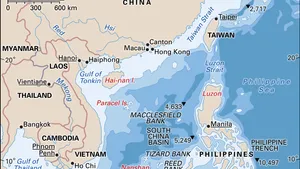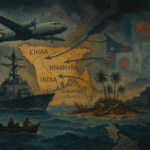
The South China Sea and South Asia have become focal points in the current geopolitical landscape, with numerous countries vying for control and influence over strategically important territories. This essay will explore the latest geopolitical facts and figures in these regions, discuss the tangible threats faced by smaller countries in the area, and assess the safety of Taiwan and India amidst growing Chinese assertiveness.
South China Sea and South Asia: Geopolitical Facts and Figures
The South China Sea is a major global trade route, with an estimated one-third of international shipping passing through its waters (Council on Foreign Relations [CFR], 2020). It is also rich in natural resources, including oil, gas, and fish stocks (The Economist, 2020). This has led to numerous territorial disputes involving China, Vietnam, the Philippines, Malaysia, Brunei, and Taiwan (Buszynski, 2020).
In South Asia, the rise of China has significantly impacted regional dynamics, primarily through the Belt and Road Initiative (BRI), which aims to enhance China’s economic and political influence in the region (Liu & Dunford, 2016). As a regional power, India has sought to counter China’s increasing presence in South Asia by strengthening its military and economic ties with countries like Japan, Australia, and the United States (Kugelman, 2020).
Tangible Threats Faced by Smaller Countries
Smaller countries face several tangible threats due to ongoing geopolitical tensions. These include resource competition, militarisation of disputed territories, and the potential for regional conflict (Buszynski, 2020). In addition, smaller nations may experience economic coercion from more extensive powers like China, which has utilized financial tools to pressure countries into supporting its political and strategic objectives (Kastner, 2020).
Taiwan’s Security and Prospects
Taiwan faces unique challenges due to its complex relationship with China, which considers the island a renegade province and has not ruled out the use of force to achieve reunification (Wong, 2020). With China’s military modernization and increasing assertiveness, Taiwan’s security situation has become increasingly precarious (Tiezzi, 2021). In response, Taiwan has sought to strengthen its self-defence capabilities and deepen its ties with regional allies like the United States (Hsiao, 2020).
India’s Security and Potential for Conflict with China
India’s security situation is also a cause for concern due to its longstanding border disputes and rivalry with China (Laskar, 2021). The 2020 border clash between India and China in the Galwan Valley has highlighted the potential for escalation between the two nuclear-armed powers (BBC News, 2020). However, India’s strong military capabilities and strategic partnerships with countries like the United States, Japan, and Australia may act as a deterrent against a Chinese-initiated conflict (Pant & Joshi, 2020).
The South China Sea and South Asia are vital regions with complex geopolitical landscapes. Smaller countries in these regions face tangible threats from resource competition, militarisation, and potential conflict. Taiwan’s security situation is increasingly precarious due to China’s growing assertiveness, while India’s security depends on its military capabilities and strategic partnerships. Maintaining regional stability and security will require careful diplomacy, cooperation, and a commitment to international law as the geopolitical landscape continues to evolve.
Military Capabilities
India’s military prowess is a significant factor in its ability to defend against Chinese aggression. The country has the world’s third-largest military, with over 1.4 million active personnel (Global Firepower, 2021). India’s defence budget has also increased, reaching $73.65 billion in 2021 (SIPRI, 2021). Additionally, India has been investing in modernising its armed forces, developing advanced weaponry and enhancing its intelligence, surveillance, and reconnaissance (ISR) capabilities (Aneja, 2020).
Strategic Partnerships
India’s strategic partnerships also contribute to its ability to deter Chinese advances. The country has strengthened its ties with major powers like the United States, Japan, and Australia. For instance, the Quadrilateral Security Dialogue (Quad) – comprising India, the United States, Japan, and Australia – aims to maintain a “free, open, and inclusive Indo-Pacific” and serves as a counterweight to China’s growing influence in the region (Panda, 2020). These partnerships enable India to access advanced military technology, participate in joint military exercises, and bolster its defence capabilities.
Geographic Advantages
India’s geography offers it a natural defence against potential Chinese aggression. The mountainous terrain along the disputed India-China border, particularly in the Himalayas, poses significant challenges for any invading force (Mazumdar, 2020). The high-altitude environment, harsh weather conditions, and limited infrastructure make it difficult for both sides to sustain large-scale military operations, thereby working to India’s advantage.
Conclusion
India is well-equipped to repulse Chinese aggression and protect its territory thanks to its military capabilities, strategic partnerships, and geographic advantages. As long as India continues to invest in its defence infrastructure and maintain strong alliances, it should be able to deter any potential Chinese advances.
References
BBC News. (2020, June 16). India-China clash: 20 Indian troops killed in Ladakh fighting. https://www.bbc.com/news/world-asia-53062484
Buszynski, L. (2020).
Aneja, A. (2020). India’s military modernisation: Challenges and prospects. Observer Research Foundation. https://www.orfonline.org/research/indias-military-modernisation-challenges-and-prospects/
Global Firepower. (2021). 2021 Military Strength Ranking. https://www.globalfirepower.com/countries-listing.php
Mazumdar, M. (2020). The India-China border dispute: What you need to know. Al Jazeera. https://www.aljazeera.com/news/2020/6/17/the-india-china-border-dispute-what-you-need-to-know
Panda, A. (2020). The Quad comes of age: Power politics and the Indo-Pacific’s new strategic equilibrium. War on the Rocks. https://warontherocks.com/2020/10/the-quad-comes-of-age-power-politics-and-the-indo-pacifics-new-strategic-equilibrium/
SIPRI. (2021). SIPRI Military Expenditure Database. https://www.sipri.org/databases/milex







Pondok88: Portal Slot Gacor dengan Bonus New Member 200 Tanpa Ribet!
What i do not understood is if truth be told how you are no longer
actually much more smartly-preferred than you may
bbe now. You’re soo intelligent. You recognize therefore significantly in terms of thyis subject, produced me in my opinion consider it from numerous varied angles.
Its like women and men are not interested except it is one thing to accomplish with Woman gaga!
Your personal stuffs excellent. All the time handle it up! https://glassi-freespins.Blogspot.com/2025/08/how-to-claim-glassi-casino-free-spins.html